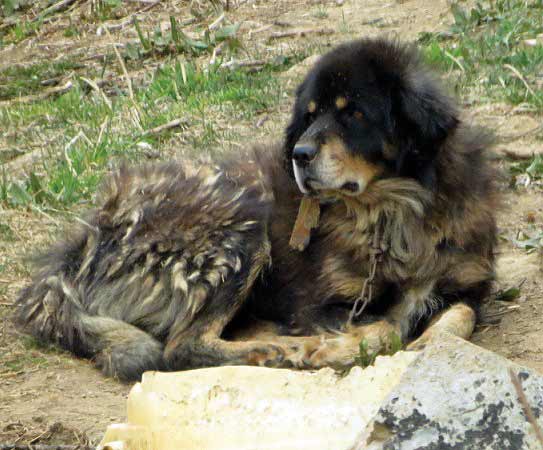Tally Ho! My oldest friend flew from New Zealand, as I organized two vintage Classic 350cc Enfield Bullet motorcycles. We set out to travel Nepal’s eastern to western borders, divided by the Mechi and Mahakali Rivers. Predominantly travelling along the southern border’s East-West Highway and north to Lord Muktinath’s icy Himalayan abode in the moonscape Mustang region. We would clock 3,500Km, broken bones, a wardrobe of universal experience and the ability to say: “We had us a bona-fide adventure!”
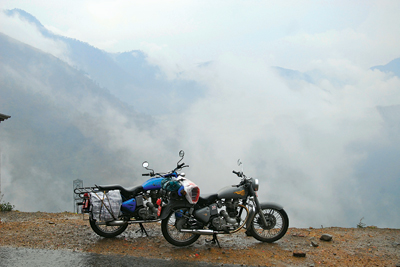 Wagons Ho!
Wagons Ho!
Rosebud’s the sweetest machine a man could lay eyes on: with tasty grey tone, rounded clean perfect curves, giving soft sweet thuds from its engine. You could almost call her a lady. Nearly 40 years old, she was amongst Nepal’s first police motorcycles. Juggernaut was her complete opposite—though the same model. He was 25 years old, sporting a worn cobalt paint-job, leaking oil from his head. Where Rosebud flowed a soft thud, Juggernaut gave a barbaric throb, he’d previously been with the Indian Army on Himalayan duty. Everywhere we went heads turned.
A friend’s hostel organized a ritual in Swoyambhu for success and safety, presided by four Buddhist monks and four Hindu fakirs. Gods appeased, we collected parts, tools and essentials, while members of Swoyambhu’s Vintage Gurkhas Motorcycle Club—who’d organized Rosebud for me—gave our last servicing. We were ready to embrace the lands and fortunes.
My childhood friend Ian entered the unknown; it was his first time in Asia. I was on the road to escape. On a bright April morning with perfect azure skies we headed south on Nepal’s oldest road: the Mahendra Highway, built in 1957. The newly black topped road from Kathmandu to Hetauda was a dream - beautiful curves gliding through middle hills. Staggering views waited from top of Bhimpedi: south onto the plains of India and north to towering Himalayas disappearing into the evening’s cloak. We visited the Kalitop Fort and its numerous canons, which kept invading armies out through centuries.
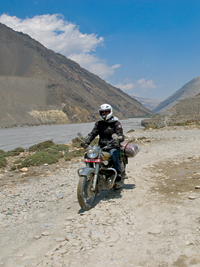 Our descent to the plains was shrouded in pre-monsoon showers. Bolts of lightning illuminated the darkening sky and the torrential rains drove us to shelter in Hetauda’s bus depot. It was Ian’s first tropical storm in full fury. Afterwards we hit the fresh night towards Jeetpur, an industrial blimp on the highway to Birgunj and its border with India. There we would be guests at the Bengali baba’s ashram.
Our descent to the plains was shrouded in pre-monsoon showers. Bolts of lightning illuminated the darkening sky and the torrential rains drove us to shelter in Hetauda’s bus depot. It was Ian’s first tropical storm in full fury. Afterwards we hit the fresh night towards Jeetpur, an industrial blimp on the highway to Birgunj and its border with India. There we would be guests at the Bengali baba’s ashram.
The Tarai would prove a rough experience: heat, mosquitoes and lack of communication due to my Nepalese becoming useless in these lands of Hindi, Bhojpuri and Maithali amongst others.
Mobile armchairs
Driving long straight highways on a Bullet is a dream. Heavy as they feel, it’s like traveling on an armchair. Yet these roads require constant attention; to the bikes’ running condition and awareness of fellow travelers: overloaded snail-paced Tata trucks, hurtling night buses, carts laden with bamboo pulled by gigantic oxen and motorcycles with families of riders. Then there are goats, cows and buffalos moving for grazing… the list of oddities was endless.
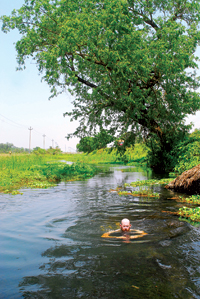 En route to the far-east’s verdant hilly tea estates in Ilam District and the eastern border with India, we traveled stretches where the day’s heat raised vapors off the highway in desert-like country. Other times dense, lush, humid jungles stretched forth beyond sight.
En route to the far-east’s verdant hilly tea estates in Ilam District and the eastern border with India, we traveled stretches where the day’s heat raised vapors off the highway in desert-like country. Other times dense, lush, humid jungles stretched forth beyond sight.
Hurtling on highways through Bara District we absorbed flourishing hardwood forests lining the highway; until Rosebud shuddered to a halt, her gearbox smashed. Under sweltering sun, a friendly mechanic got us into neutral—with his knowledge. Juggernaut towed Rosebud with Ian holding the line for 70km back to Birgunj and capable hands. What a horrid ride, through chaotic evening traffic into this industrial border city; between oxen, trucks, buses and tuk-tuks to Islam the mechanic and the parts we needed.
It would become two days of waiting, suffering hell’s heat. Mosquitoes found Ian’s Irish blood to be a delicacy. Yet all bad experiences ended and soon we were back on our way—travelling fresh territories.
The districts flew past us, sometimes without us knowing where we were, with only the faces, clothing and architectures changing. But even in the oppressive heat, the land had unique, fun experiences: Nepal’s last herd of wild buffaloes at Koshi Tappu Nature Reserve; riding on the roof of the last passenger train in Janakpur and the Disneyland-esque temple complex of Kotihom in Jhapa District.
Yet the instant we moved upon the luscious winding hills of Ilam all our difficulties fell away. Days were spent in Shree Antu Dhara, where the first light of day touches Nepal. We were 15 minutes from the Mechi River and Nepal’s eastern border. Here was every tea-fanatic’s paradise, with locals growing some of the finest leaves in Nepal.
It would be sad to leave this heavenly place and the kindest hosts I have met in my years in Nepal. For Ian it was difficult thinking of heat and mosquitoes, forgotten due to our balmy location.
Beware Of Shortcuts
Bored with driving on the same highway—now aiming west for Pokhara—a look at maps was called. We saw the new Sindhuli Highway running between Bardibas near Janakpur to Kathmandu’s Dhulikhel. It seemed good enough to travel (on paper) and after asking we were sold and gave change a chance.
From Bardibas we were amazed by the rich road we encountered as we rode into balmy middle hills, driving along the newest highway whose construction is supervised by the Japanese. Red earth glowed in evening’s light as we gazed upon verdant forests as far as eyes roamed.
Again faces changed to Mongolian and homes were no longer the mud huts and bricks belonging to Tarai folks, becoming two-story wooden ones. Cruising, we felt free and clear; nearly no other vehicle passed us. Locals said Kathmandu was only five hours away. We traveled on, not worrying about night; with such ergonomic roads ahead we could reach Kathmandu quickly, change clothes and continue to Pokhara next day. How naive we were!
As night closed, the corkscrew roads made us feel as if we drove on super-Swiss highways. But soon the bubble burst, hitting roads under construction. A policeman said only a few hours to Kathmandu and soon we would be through the boulder strewn red-dust road.
Hell Has A Location
Over hills and through streams we went, the road getting rougher as night thickened. On we went over testing surfaces until Rosebud gave a smashing sound and halted in Nowheresville. Ian was on the verge of breaking down at thought of Rosebud not being fit for journeying. We took turns consoling one another. Shuddering at thoughts of organizing a truck we pitched our tent and slept with angst in our hearts.
Morning time opened our heavenly hillside location. Rolling red hills shimmered to life, as an icy river flowed far below the ravine we were upon. With daylight I spied our woe’s culprit: a broken chain. We jumped joyously; having a spare link made it a problem we could fix. Foolishly we thought the worst over.
Onwards we went, thinking of Kathmandu treats like coffee, showers, friends and servicing for our valiant chariots. But ahead was a hellish ride of rough ascents and slippery descents taking every inch of our effort. The thing about Bullets is they are heavy beasts, 200Kgs when empty, but ours were with riders, equipment, fuel and cages. Making hauling them over rough hills was a job requiring lots of power and strength, all while the sun pounded down.
Yet we still recognized being in one of Nepal’s most beautiful areas, lined with the largest, widest Pipalbot tress I ever saw. This was a real hardcore off-road experience making us appreciate highways. With all the revving, I feared my fuel calculation would be askew.
Hours ticked by as we struggled until finally spying our last descent onto asphalted-heaven and the Sindhuli River next to it. We raced passed yellow-helmeted road crews towards inviting waters and ways. Both of us smiled, almost beaten by the experience endured. A man asked where we came from: “from up there”. He’s shocked: “What? You came from there? That is danger road!”
Onward we drove until our last drop of fuel was drunk, both machines empty at the same time. Hoping on a bus, I went to fetch petrol. Upon my return, pouring the liquid gold into Rosebud, we watch it flow right out its carburetor—No!
In went Rosebud into a farmer’s shed, we would complete the journey on Juggernaut. The highway with its 60km hell-stretch cost 18 hours, a chain-debacle, two clutch plates, a new carburetor and a friendship tested and two days for a mechanic to get Rosebud operating.
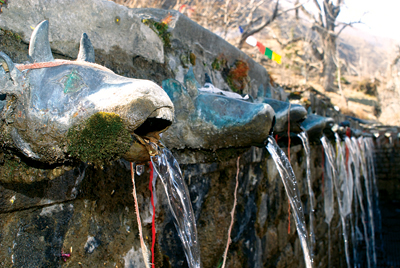 Move Little Horsies
Move Little Horsies
With clothing changed for Himalayan journeying we were ready for the tourist paradise of Pokhara and the road north to Muktinath in Mustang. Home to the Hindu God Lord Vishnu—king of the gods—we hoped our pilgrimage-of-sorts would be an easier affair than what we had experienced till then.
Pokhara was a heavenly paradise after the ordeals we’d struggled against. Ian glowed under Himalayan views - his first white peaks. The fruits of Pokhara spoiled us after too many dal-bhats: coffee, smoothies, pizza and more. We gorged upon them knowing it would be a while. As we enjoyed our treats, Rosebud and Juggernaut enjoyed a service at the hands of Nepal’s finest Enfield mechanic: Raju from the Bullet Surgery, tightening this and loosening the other.
A third member now joined our posse, a brother named Marco. His sense of humor would become invaluable. He purchased a second hand Yamaha RX100 the day before. Being larger than Ian and I, Marco was comical in size to us on our beasts. Yet we smiled in appreciation as the RX100 is what we learned to drive on.
The road though new was no means perfect. Before Beni—Mustang’s gateway—the blacktopped road faded into memory and thus began days of jostling interspersed with wet deluges and cutting winds flowing from Annapurna’s bosom.
It took three days to Jomsom, every step - no matter how difficult over rough roads and through small lakes and waterfalls - was worth it as we spied upon the Kali Kandaki River’s floodplain and the beginning of Mustang’s moonscape setting. Dhaulagiri mountain was the first to be seen peeking at us as we made our way through farmlands of golden grains and pungent forests. The whole road was ours except for the odd jeep or bus filled with pilgrims heading to Lord Muktinath—interspersed with odd trekkers.
 Praise Be
Praise Be
The whole journey felt like a special pilgrimage, one unique to the world in geography and culture. As one passes Nepal’s apple capital of Marpha, the geography changes taking on shades of the moon, with rounded barren hills topped by Dhauligiri and Nilgiri ranges. Shades of yellows, beiges, reds and auburns melt with the land’s barrenness. A respect grows for those who make their lives here, particularly when biting icy winds blast down Kali Gandaki’s wind tunnel.
It would be a life changing experience testing us against land, machine and self over this rocky playground. Jomsom brought respite for a night before our push into the top of Lower Mustang and Muktinath. We stayed with friends from hotel Alka Marco Polo, enjoying hot showers, clean beds and everything but dal-bhat.
After a breakfast of apple crumbles, we aimed for Kagbeni, a town that practices Tibetan Buddhism in a near uninterrupted method since bygone days. First we had a suspension walkway to negotiate before being thrown around the Kali Gandaki’s dried riverbed over boulders and depressions.
Kagbeni glistened in the midday sun, its red monastery standing tall above the fort city’s crumbling walls. From here is the entrance to upper Mustang and the junction to Muktinath. Behind, Upper Mustang stretched out, inviting us to experience its wild and evocative landscape—permit restrictions made that impossible—yet we were still thankful watching the sun set over shimmering hills.
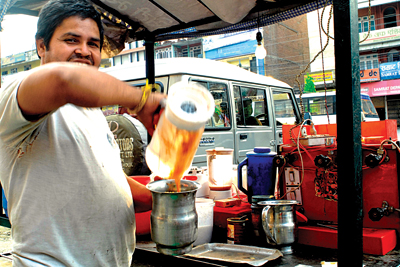 In the depths of morning, we straddled into the final ascent from 2,800m to 3,700m. As we made the 17km journey, the day unfolded before us, taking on tones and hues matching the surrounding hills. Mountain ranges opened as we peered into unknown lands. Smiles grew with altitude and views. Arriving at our most northerly point we gave thanks to Lord Vishnu, making a point to splash ourselves from each of the 108 fountains spouting around the temple.
In the depths of morning, we straddled into the final ascent from 2,800m to 3,700m. As we made the 17km journey, the day unfolded before us, taking on tones and hues matching the surrounding hills. Mountain ranges opened as we peered into unknown lands. Smiles grew with altitude and views. Arriving at our most northerly point we gave thanks to Lord Vishnu, making a point to splash ourselves from each of the 108 fountains spouting around the temple.
Proceeding to the 1070 year-old Gella Mukhi Nunnery, we got the opportunity to recognize all five natural elements living harmoniously together. Here a natural gas flame glows inside, a stream flows underneath, sitting on the earth where wind moves, while the sky sits overhead.
It was a special moment for us, standing on top of the world after struggling against nature, man and machine. Whether it was long-termers like Marco and I or newcomers to Nepal like Ian, the location and experience was one sure to stay all our days as one of those special moments in life—lasting beyond kilometers.
For Ian and I it was a feeling of momentous achievement; we had now been north, south and east, only west was left. We reached Pokhara three days later, had a hot shower, coffee and a culinary treat or two. We were back on the road—as a unit of two again—after our babies had a post-Himalayan service with their Uncle Raju.
The Wild West
Time was running short. Only four days to get to the western border and back to Kathmandu before Ian’s flight. From Pokhara we cruised south through Syanja, twisting on caressing curves into the sunset aiming for the Tarai city of Butwal. Red earth shimmered around us as post midday’s sun began ceasing its journey. We were hungry, not for sustenance, but to get ourselves west, far west. Only a mere 1,500 odd kilometers lay to Kathmandu.
Just after sunset we arrived to Butwal as high winds blew dust like a movie scene. Staying here we enjoyed nighttime coffee lassis, a famous product of the city. We tried beating the oncoming sun and its power with an early start, but soon after leaving the city Rosebud began overheating. What to do? We were between nowhere and not-really-anywhere, without mechanics and with time ticking by.
A bright thought sparked and requested the police’s assistance to care for Rosebud while we raced ahead on Juggernaut. The police of Nowheresville were happy to help us two grizzly looking travelers. Juggernaut was stripped of everything except tool-bag, parts and extra t-shirt each. Rosebud was stripped of fuel in a solemn moment. We bade goodbye to our wounded companion until we could figure out getting her to Kathmandu—we raced into midday’s inferno.
Taking turns at the wheel we chewed road fast, passed Tharu villages of mud huts; that was until we hit an all-west bandh (strike). It again took sweet-talking but the police of the west finally gave us a travel-pass. The next 400km from the Rapti River would be every drivers dream—closed roads opened before us—the straightest, best roads of the land almost, through the national parks and forests of Banke and Bardia. Onwards we went, but not through verdant forests: burned-out and charred stretches filled with the cremated ashes of dead forest-life. Giving our experience an ominous feel—one that would spookily turn true.
As the sun settled on another Tarai day, we stopped for a last tea and figuring there was only 100km left till our destination, we decided to drive on. As we pushed on it was hard to not notice the red full moon rising to our backs. Under night’s cloak we moved ever closer to the Mahakali River, food and lodging. Our timing was good only eight o’clock and 60Km to go, that was until…
 Obstacles Ahead
Obstacles Ahead
The day’s first car drives towards us with full headlights, drowning the power of Juggernaut’s bulb, not seeing a foot in front. A line of boulders lay across the road—left by agitators—ten foot in front. Ian slams the brakes, but it is too late and releases it again, aiming for the smallest boulder to make a jump. All goes well until it doesn’t.
Up we fly in daredevil style and thrown-off as Juggernaut flips mid-air. Off we go to the right, I land on top of Ian, as our valiant steed continues ahead. I quickly check for broken bones. Ian is up screaming and wailing, at least he’s okay to scream I think and run to get Juggernaut off the road.
Quickly it becomes evident that Ian is not so lucky, he’s on the ground wailing: “Support my elbow—lift it up”. Locals gather quickly removing offending boulders.
Within minutes police and ambulances are on scene. Ian’s whisked to a random Tarai highway hospital as I follow on a bent Juggernaut—remarkably starting first try.
Instantly plans are asunder. No plane for Ian, no returning to Rosebud and no far-western border—lost by 40-odd Kilometers. Due to strikes, poor hospitals and the general difficulties of the country it would take Ian a month to get home, with three surgical plates as souvenirs. To get to that point would see us riding on Juggernauts’ bent back all the way to Pokhara, through nationwide strikes with broken bones.
Epilogue
As Ian climbed onto his plane he smiled, amazed that in the face of every problem from broken chains to bones, low fuel to horrendous roads, answers were always conveniently nearby. As wacky a country Nepal had proven to be we had no doubt we partook on an adventure, a true bona-fide one—Nepal, Dhanyabad! ■



